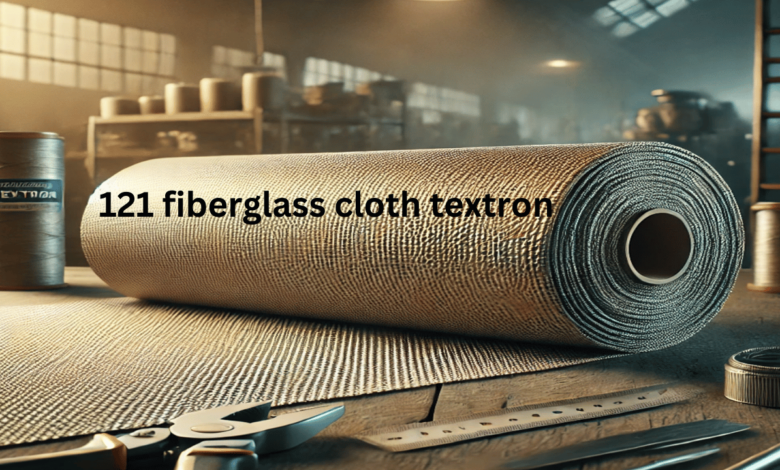121 Fiberglass Cloth Textron: A Comprehensive Guide to its Features, Applications, and Benefits

Fiberglass cloth is a crucial material in numerous industries due to its strength, flexibility, and resistance to various environmental factors. One of the most notable types of fiberglass cloth is the 121 fiberglass cloth textron, known for its durability and versatility in a wide range of applications. This article explores the various aspects of including its features, benefits, applications, handling tips, and much more. By the end, you’ll have a deep understanding of why this material is so highly regarded in industries like aerospace, automotive, marine, and construction.
What is 121 Fiberglass Cloth Textron?
The 121 fiberglass cloth textron is a high-performance woven fabric made from glass fibers, designed to meet demanding standards in industries requiring durability, strength, and lightweight materials. Manufactured by Textron, a global leader in advanced materials, this fiberglass cloth combines impressive mechanical strength with resistance to heat, moisture, and chemicals. Its versatility makes it suitable for a wide range of applications, from structural parts in aerospace to reinforced components in automotive manufacturing.
Features of 121 Fiberglass Cloth Textron
The 121 fiberglass cloth textron offers several key features that make it stand out from other types of fiberglass cloths. Below are some of its most prominent features:
Strength and Durability
One of the most significant advantages of exceptional strength. The glass fibers woven into the fabric provide superior tensile strength, allowing the material to endure mechanical stresses without breaking or deforming. This characteristic makes it ideal for applications where structural integrity is critical, such as in aerospace components or reinforced automotive parts.
Lightweight Yet Strong
Despite its strength, the 121 fiberglass cloth textron is relatively lightweight. This quality makes it a popular choice for industries like aerospace and automotive, where reducing weight is often a key factor in improving fuel efficiency and performance. The lightweight nature of this cloth makes it easier to handle and integrate into products without sacrificing its strength.
Heat and Chemical Resistance
Another standout feature of 121 fiberglass cloth textron is its ability to withstand high temperatures and exposure to various chemicals. This resistance ensures that the material can maintain its integrity and performance, even in harsh environments. Whether it’s used in high-heat applications in aerospace or exposed to chemicals in automotive manufacturing, remains reliable.
Flexibility for Complex Applications
Despite its toughness, 121 fiberglass cloth textron is also highly flexible. This flexibility allows it to be cut and shaped into various forms, making it suitable for a wide range of applications. It can be used in intricate designs without compromising its structural integrity, allowing for greater creativity and precision in product development.
Applications of 121 Fiberglass Cloth Textron
The versatility of makes it suitable for numerous industries, each benefiting from its unique properties. Below are some of the primary industries and applications where 121 fiberglass cloth textron is commonly used.
Aerospace
In the aerospace industry, is used extensively for components that require strength, heat resistance, and light weight. The fabric is commonly found in structural parts, insulation materials, and wiring. Its ability to withstand extreme temperatures and mechanical stresses makes it an ideal material for aircraft components that are exposed to demanding conditions during flight.
Aerospace Applications of 121 Fiberglass Cloth Textron
- Structural Components: Parts of the aircraft’s body that must endure high pressure and stress, such as fuselages and wings, often use 121 fiberglass cloth textron for reinforcement.
- Insulation: This fiberglass cloth is used as an insulation material in electrical wiring to prevent overheating.
- Heat Shields: Components that protect sensitive parts from intense heat can benefit from the heat resistance of 121 fiberglass cloth textron.
Automotive
The automotive industry also takes advantage of 121 fiberglass cloth textron for its lightweight and durable properties. In vehicle manufacturing, this material is used to reinforce various parts, from body panels to interior components. It contributes to improved fuel efficiency by reducing the overall weight of vehicles while maintaining high structural integrity.
Automotive Applications of 121 Fiberglass Cloth Textron
- Body Panels: Lightweight yet strong, is ideal for reinforcing body panels, reducing the vehicle’s overall weight without sacrificing strength.
- Interior Components: The material is also used in the production of interior components, such as dashboards and trim pieces, offering durability and resistance to wear.
- Structural Reinforcement: Components that experience high stress, such as undercarriages and chassis, often incorporate to enhance strength and longevity.
Marine Industry
The 121 fiberglass cloth textron is highly valued in the marine industry due to its ability to resist water and saltwater exposure. Boats, ships, and other marine vessels require materials that can withstand harsh environmental conditions, and fits this need perfectly.
Marine Applications of 121 Fiberglass Cloth Textron
- Boat Hulls: 121 fiberglass cloth textron is used in the construction of boat hulls, where its strength and resistance to water make it an ideal choice.
- Decks and Structural Components: In addition to hulls, this fiberglass cloth is used for reinforcing decks and other key structural parts of marine vessels.
Construction
In the construction industry, is often used as a reinforcement material in various construction projects. Its ability to enhance the strength and durability of concrete and other building materials makes it an important component in many construction applications.
Construction Applications of 121 Fiberglass Cloth Textron
- Reinforced Concrete: 121 fiberglass cloth textron is used in the reinforcement of concrete, adding extra tensile strength and resistance to cracking and breaking.
- Building Insulation: The heat resistance of this material also makes it ideal for use in insulation products, protecting buildings from temperature fluctuations.
How to Handle and Apply 121 Fiberglass Cloth Textron
While working with 121 fiberglass cloth textron, it is essential to follow proper handling procedures to ensure its effectiveness and safety. Here are some key tips for working with this material:
Cutting and Shaping
To cut 121 fiberglass cloth textron, use sharp scissors or a utility knife to achieve clean edges. The fibers can be tough, so a sharp cutting tool ensures that the material doesn’t fray during handling.
Safety Precautions
When handling fiberglass cloth, including it is crucial to wear protective gloves to avoid skin irritation from the glass fibers. It is also advisable to wear a dust mask or respirator when cutting or sanding fiberglass to avoid inhaling tiny glass particles. Always work in a well-ventilated area to reduce the risk of fiberglass dust inhalation.
Application with Resin
To bond to other materials, apply a compatible resin, such as epoxy or polyester. The resin helps to reinforce the fiberglass and improve its durability. Make sure to follow the manufacturer’s instructions for resin application to achieve optimal results.
Why Choose 121 Fiberglass Cloth Textron?
There are several reasons why 121 fiberglass cloth textron is a preferred material in various industries. Its unique combination of features makes it an ideal choice for applications where strength, heat resistance, and durability are essential. Whether you’re working in aerospace, automotive, marine, or construction, offers significant advantages that can enhance your products’ performance and longevity.
Frequently Asked Questions (FAQs)
1. What is 121 fiberglass cloth textron used for?
121 fiberglass cloth textron is used in aerospace, automotive, marine, and construction industries for reinforcement, structural components, and insulation. It is valued for its strength, heat resistance, and lightweight properties.
2. Is 121 fiberglass cloth textron heat-resistant?
Yes, 121 fiberglass cloth textron is highly heat-resistant, making it suitable for use in high-temperature environments like those found in aerospace and automotive applications.
3. How do I apply 121 fiberglass cloth textron?
To apply you need to use a compatible resin, such as epoxy or polyester. It is important to follow the manufacturer’s instructions to ensure a strong bond.
4. Can I use 121 fiberglass cloth textron for marine applications?
Yes, is widely used in the marine industry, especially in the construction of boat hulls and decks due to its resistance to water and saltwater.
5. How should I handle 121 fiberglass cloth textron safely?
When handling 121 fiberglass cloth textron, it’s essential to wear protective gloves and a dust mask to avoid skin irritation and inhaling fiberglass dust. Always work in a well-ventilated area to reduce health risks.
Conclusion
In conclusion, 121 fiberglass cloth textron is an invaluable material with widespread applications in numerous industries. Its combination of strength, durability, heat resistance, and flexibility makes it an ideal choice for products that need to withstand harsh conditions. Whether used in aerospace, automotive, marine, or construction, this fiberglass cloth continues to prove its worth, offering a reliable solution for a variety of high-performance applications.
Read More:196922566080 on Walmart: Understanding Product Identifiers and Their Importance




